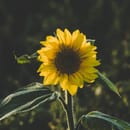On a little trip to the 99 cents store with some friends last spring semester, I bought a sad little money tree for three bucks. I hadn’t had much luck growing plants in the past, but I thought that just maybe I could use this little tree to turn that luck around. As it became apparent that COVID-19 wasn’t leaving any time soon, and that I’d be spending more time indoors than originally anticipated, I decided to add a few more plants to my collection: a snake plant, some anthurium, and a croton. The longer these plants stayed alive (and grew!), the more I was inclined to buy more plants. As it currently stands, I have 18 plants under my care in various sizes, ranging from a 3-inch pot of African violet to a 16-inch pot of monstera. I’ve come to enjoy calling my collection my own very interior jungle, a wide variety of varying shades of greens and reds of differing shapes and sizes. Taking care of houseplants seems a little tedious at first, but I promise you— there is a plant for everyone!

What I wish I knew when I started
There’s a lot of aspects to plant care that seem quite overwhelming at first, but for a beginner, there’s pretty much only 4 things you should know about: watering, light exposure, soil types, and humidity. A lot of people think they need to water a plant every day, but I’ve found many houseplants prefer to be watered every couple of days! Some like to be a little on the moist side, but usually don’t require daily watering. An easy way to gauge whether a plant needs to be watered or not is to just poke your finger into the soil— feel if the soil is still damp and consider that plant’s needs. If the soil of my pancake plant still feels a little damp, I’ll wait another day to water it because the pancake plant prefers to have dryer soil. But if the soil of my coffee plant feels only a little damp, I’ll give it a little more water, because it prefers wetter soil.
Light exposure is also a key component in keeping your plant healthy! It should come as no surprise that some plants like lots of sunlight, while some prefer just a bit of indirect light. The key thing to remember is that if your window faces the north or east, it gets a low amount of sunlight, and if it faces the west or south, it gets a high amount of sunlight. Putting a plant that requires lots of sunlight by a northern-facing window may cause your plant to start drooping. On the other hand, putting a plant that requires minimal sunlight by a southern-facing window will probably give your plant a sunburn.
Soil type is also important. Soil can be water-retaining, or it can be water draining. Certain plants really prefer to have a soil that locks in the moisture from watering. Others prefer soil that allows any excess moisture to drain away quickly. I’ve had a bit of luck sticking to all-purpose soil for most of my plants, but for my more high-maintenance plants I do tend to listen to what they need more. MiracleGro offers a nice variety of soil types, as well as a soil mix specifically catering to indoor plants as well— it’s more on the fluffy, well-draining side, which is a common preference among indoor plants.
I believe humidity often gets ignored by a lot of first-time plant owners. Similar to light exposure, certain plants require a higher amount of humidity to thrive. There’s a couple of simple hacks to improve the humidity near your plants. The easiest is to purchase a mister and occasionally mist them. I find misting plants to be pretty relaxing and it helps me stay engaged in plant care on days where I don’t need to water or trim any of my plants. The other way of tackling humidity is putting together a humidity tray: in its simplest, a humidity tray is a tray with gravel or rocks covering the bottom with water poured in just below the top of the rocks. Placing humidity-loving plants on humidity trays makes the air around the plant more humid than before.
Knowing where the plant originates can help to understand the plant’s secrets. Tropical plants enjoy the same conditions they would be living in if they were in the wild: warmer climates, more sun exposure, and more humidity. Plants from dryer climates prefer less humidity and prefer to be under-watered, than over-watered.
The perfect plant for you
So, you’ve decided you’d like to start caring for houseplants. But what plant should you start with? The answer varies depending on the light exposure you get, and how much watering you’d like to do. If in doubt, however, pothos is always a solid option. Pothos grows like crazy when it’s healthy and is very easy to understand. You will know when it’s been watered too little or watered too much, as the leaves will start to curl at the tip. I’ve found it doing well in most varieties of light exposure, and it tolerates all-purpose soil.
If you have lower exposure, you might want to look into ZZ plants or a snake plant. Both enjoy less light and are hardy plants. My ZZ plant grows slow, but when a new stem shoots out, it’s very exciting to watch the leaves open up over a few days! Snake plants are a little harder to read in my opinion. They grow much slower, but they tolerate more conditions than other plants. I keep mine in all-purpose soil with no drainage, and it does fine!
Have a southern-facing window? No problem! Anthurium and crotons enjoy sunny rooms! Both are pretty cheap and can come in smaller pots but can also be quite large. In my experience, crotons do not like to be watered unless their soil is dry, while anthurium can handle more frequent watering. However, if you have pets at home that like to chew on things or eat what they’re not supposed to, anthurium is not the plant for you. It is highly toxic when ingested to both pets and humans and can also cause skin irritation if touched too much. The ASPCA has lists of plants that are toxic to pets available online for free.
Overall, caring for plants has improved my life. I enjoy monitoring the growth of new leaves, seeing how each plant is faring, and tending to their needs. I help keep them alive and they help brighten my day. Taking care of plants has helped me maintain a routine when I normally wouldn’t have much of one, staying inside all day. I hope I can encourage you to go out and start caring for your own plants, enjoying the little joys they can bring you as well.




